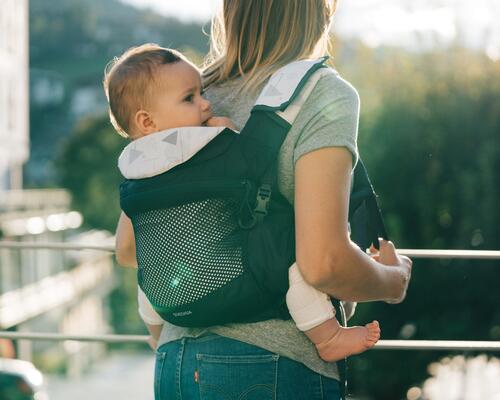What are the different means of physiological baby carriers?
There are half a dozen categories of baby carriers.
They can be found in specialized shops as well as in childcare chain stores; but baby carrying products have become more democratic in recent years and innovations in physiological baby carriers are multiplying for ever more comfort.
Carrying slings
This is the most basic and easy way to carry: woven slings or baby carriers in stretch fabric, with or without elastane.
Woven slings will be less stretchy than so-called knitted slings, in stretch.
These are made of cotton, mostly organic, with spandex fibres. Some models can contain up to 30% bamboo, always with the aim of strengthening support while being flexible.
We recommend stretch slings for premature babies, their fabric, sometimes up to 100% organic cotton, provides more warmth and softness.
It will be necessary to adapt the weight of the fabric to the weight of the baby being carried.
Count up to 250 grams for infants, then 300 grams for heavier babies. Woven or knitted, these baby slings can be used from birth.
Allowing three knot systems, you can opt for a front carry position, a hip carry position, then a back carry position for older babies.
But you also need to know how to tie these famous knots and install the baby properly.
There are many tutorials online but it can quickly scare some parents.
Specific training workshops are recommended if you wish to be reassured.
Ring slings
Also in fabric or mesh, the sling attachment system is made using two rings, which passes over a single shoulder.
The particularity of carrying in a sling, also called carrying in a hammock, is that it is therefore asymmetrical, the baby's weight is not evenly distributed. This can become uncomfortable in the long term for some.
This baby carrier without a knot or loop sling does not require specific training like a basic sling.
Special mention: it allows you to breastfeed in complete privacy.
Note, that there is a water-sling.
Thanks to its special, light and airy fabric, which dries quickly, it allows you to go swimming with your child or carry it in a sling, even
when it's very hot.
Meï-taï or Chinese baby carrier
Asiatic-inspired baby carrier, specialists say it is halfway between a baby sling and a preformed baby carrier.
It consists of a fabric backrest of rectangular or square shape, it attaches with two large, often padded shoulder straps and two shorter straps that tie around your stomach.
Easier to use than a sling because the seat is already "shaped" to accommodate the baby.
The physiological preformed baby carrier
Said to be preformed or structured, this baby carrier is recommended as soon as babies know how to sit and hold.
Installing your baby is made easier thanks to padded, adjustable shoulder straps and a belt that just has to be clipped together.
It is the ready-to-use solution for all parents who do not feel comfortable carrying their baby in a sling and its 5m20 of fabric.
Ready to wear, the preformed baby carrier could be compared to a backpack, offering speed and ease of installation.
At Quechua, it is our favourite means of physiological carrying because we can use it easily and without constraints when walking baby!
They offer more and more innovations to enhance outings with baby: removable or roll-up hood system, ventilation against the heat, another special feature, some models can be upgraded and can carry your child up to 3 or even 4 years old.












